
What is It?
The acronym brigade just doesn’t get any shorter these days, does it? Let’s start with all those letters:
- AF-S means internal focus using a silent wave motor. One thing that a lot of Nikon users don’t understand is that there are many variations on these motors, and focus speed varies quite a bit from the least capable to the most.
- E means that the lens uses an electronic activation of the the aperture (as opposed to mechanical). You need a D3100 or later, D5000 or later, D7000 or later, Df, D3s, D4, D4s, D5, D300s, D500, D600, D610, D700, D750, D800, or D810 body to get full compatibility with an E lens.
- FL indicates that the lens has a lightweight Fluorite element in the design.
- ED indicates that extra-low dispersion glass is used in the lens (six ED elements)
- VR refers to Nikon’s Vibration Reduction system.
Nikon spews a bunch of additional acronyms for the 70-200mm f/2.8E on their page for the lens (HRI, IF, M/A, N, and SIC). HRI is another term used for a certain type of glass that is used, in this case High Refractive Index. N and SIC are the shortcuts for Nano and Super Integrated Coatings, which reduce internal lens reflections and optimize the passthrough of light. M/A refers to the fact that you can override autofocus with the manual focus ring at any time (if the lens is set that way).
The history of the 70-200mm is:
- (2002) 70-200mm f/2.8G AF-S ED VR
- (2009) 70-200mm f/2.8G AF-S ED VR II
- (2016) 70-200mm f/2.8E AF-S FL ED VR
The tricky thing is that all of those designations look very, very close. In practice, there’s much more difference to these lenses than their designations actually indicate. But note the exact seven-year intervals between updates. The latest version is going to be around for awhile.
If you want to see how the first two lenses compare, please see my old 70-200mm f/2.8G AF-S ED VR II review. I’m going to concentrate in this article between the two most recent lenses. Both these lenses are currently available, and you may opt for one or the other depending upon your current preferences.
So where do the two most recent versions of the 70-200mm differ in terms of specs?
- The newer E version is slightly .2” (3mm) shorter and 3.8 ounces (110g) lighter.
- The newer E version gets to 1:4.8 magnification, the older one only to 1:8.3.
- As you might expect from the previous bullet, the newer E version focuses closer at 3.6 ft (1.1m) versus 4.6 ft (1.4m).
- The newer E version has the zoom ring at front, focus at rear, while the older version is the traditional focus at front, zoom at rear.
- The newer E version has an array of focus-activation buttons (programmable on many cameras) just behind the zoom ring.
- The newer E version has a slightly different formula with 22 elements in 18 groups instead of 21 elements in 16 groups.
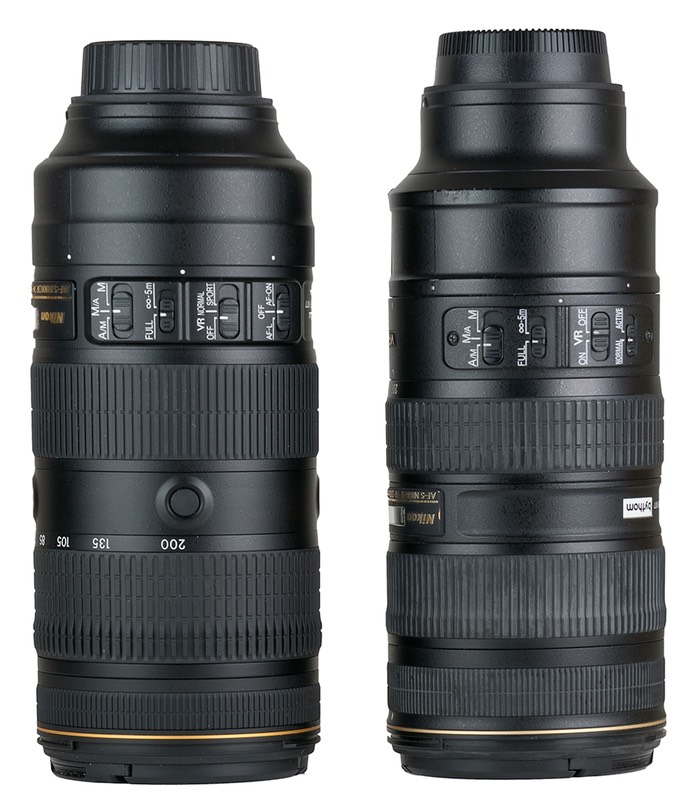
New lens on left, older VRII version on right.
From there, everything is a little tougher to differentiate, as Nikon doesn’t clearly provide deep level specifications. For instance, it seems clear to me that the VR system is quite different, but Nikon doesn’t speak to that in its marketing literature. I’ll try to do what I can with that in the performance section.
Other lens attributes you’ll want to know about include the usual 9-blade aperture diaphragm, a 77mm front filter thread, a positionable and removable tripod collar, and a supplied lens hood (HB-78), plus a nice zip-up lens case (CL-M2).
Note: the Really Right Stuff LCF-10B integrated foot/plate for the 70-200mm f/2.8G VRII will work on the new lens, though it will stick out a bit on one end of the lens support as the new lens has a smaller pad than the older one.
The zoom ring is marked at 70, 85, 105, 135, and 200mm and rotates through those in about one quarter turn of the ring. The focus indicator doesn’t have any DOF markers, and has the following markings:
- Feet: 4, 5, 7, 10, 15, 30
- Meters: 1.1, 1.5, 2, 3, 5, 10, infinity
The focus rings goes from close focus to infinity in a bit less than a half a turn.
In terms of switches you have:
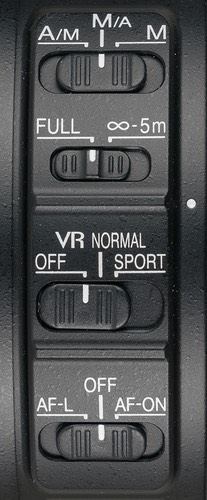
- A/M, M/A, and M — controlling how autofocus and manual focus interact
- Full, Infinity-5m — allows you to set the lens to a limited focus range (15’ near focus)
- VR Off, Normal, Sport — controls the VR system
- AF-L, Off, AF-On — controls the default behavior of the focus Fn buttons behind the zoom ring
Price for the new lens is US$2800, which is US$700 more than the lens it replaces.
The lens is made in Japan and costs US$2800.
This review is based upon two samples, one of which I purchased for my own use.
How’s it Handle?
Right up front—literally—we have to talk about the zoom ring. For almost forever Nikon professional lens designs have always been zoom-ring-nearest-camera, focus-ring-at-front-of-lens. Nikon did make a number of consumer zooms—particularly consumer zooms for DX cameras—with those positions reversed but this marks the first time we get that change in a workhorse pro lens.
More than anything else, I’m struggling to understand why the new 24-70mm f/2.8E and the new 70-200mm f/2.8E don’t match one another in this regard. The 24-70mm stays traditional, the 70-200mm switches. Yuck.
For events it’s not unusual for me to have two cameras—one with each of those lenses—hanging round my neck. I really don’t like picking up one camera and having the front ring do one thing, while picking up another lens has the front ring doing something different.
As I’ve written many times before, even small cognitive dissonances like this can slow you down just long enough to miss a critical moment. I’m not the only one who doesn’t like this 24-70mm versus 70-200mm difference. I’ve already heard from several pros who find the different ring positions between the two lenses is a nuisance as they move back and forth between them.
I’m pretty sure the design change on the 70-200mm f/2.8E is for one simple reason: engineering ease. Nikon made some early marketing mumbles about “photographers requesting this,” but I don’t know of any that did, and if we requested it why isn’t the 24-70mm f/2.8E the same? ;~) Gotcha.
Here’s the thing: I like keeping my arms tightly tucked and my palm under the center of gravity, not forward of it. No, it’s not a big thing, but it’s a thing. Remember when I noted that the 70-200mm is M/A? With the new design I can’t roll the focus ring with the ends of my strongest fingertips in a comfortable position, as I used to. Now I have to use my two smallest fingers to do that with my hand slightly twisted. Fortunately the rings are close enough so that I can manage to get fingers on the focus ring if I need to (i.e. control both rings with one hand).
While I can live with the change, I’ll go on record here as asserting that this is truly a sub-optimal design. The older design more easily allowed both changing zoom position (with your palm resting under that ring) and not having to change hand position to subtly roll focus if you wanted to. The new design allows you to still change zoom and focus, but now focus is not so subtle for me as I’m using my weakest fingers to roll that ring, and they’re not perfectly positioned for rolling focus to start with.
Of course, most shooters never get that nuanced. They just rely on autofocus to do its thing and that’s that. It’s only us old school folk that learned on manual focus that see the value of manually overriding what the camera is doing, and demand subtlety while doing it.
Still, there’s the 24-70mm versus 70-200mm difference, and that’s a real problem as you move back and forth between the lenses. You have to remember which lens you’re using. Most people will find this the bigger problem than hand position overall.
So, I don’t like the change. You might not notice or care.
Meanwhile, we get Lens Fn buttons arrayed between the rings. On a D5, for example, we can program that button to Preset focus point, AF-area mode, AF-area mode+AF-ON, AF lock only, AE/AF lock, AE lock only, AF-ON, Disable/Enable flash, 14 fps continuous (MUP), and Sync Release. A very useful set of options, actually. AF-area mode+AF-ON is highly undervalued so far with the D500/D5 users, but literally I can now have three very handy AF-ON buttons that trigger different AF Area modes (AF-On button, the focus Joystick button, and the lens button). Bingo: Single Point, Group, 24-point (or your choice of a different three). If you don’t program the camera, you have a basic ability to set the buttons to Lock focus or start Focus On via the switch on the lens.
Those buttons are handy, but I suspect that not a lot of shooters will get around to using them, let alone programming them. Pity.
Does the slightly lighter weight come into play for handling? Maybe. I certainly noticed the difference after several hours of continuous use, though the actual weight change isn’t a huge number. Any reduction here is beneficial, as long as nothing else is lost. I found the new 70-200mm a little less fatiguing in long bouts of sports shooting than its predecessor. “A little less.” Please don’t try to read too much into that.
How’s it Perform?
Focus speed: clearly a bit faster than the predecessor. This new version of the lens snaps to focus noticeably faster, but not enough to make that the primary reason to buy it. The new version of the 70-200mm also seems to follow focus a little faster on random motion, though this is very difficult to put any specific value on. Overall, a near-to-infinity or infinity-to-near focus move has improved enough to be easily measurable, and may be over 20% faster at the extreme. A definite improvement that’s appreciated, and enough to be measurable in many situations.
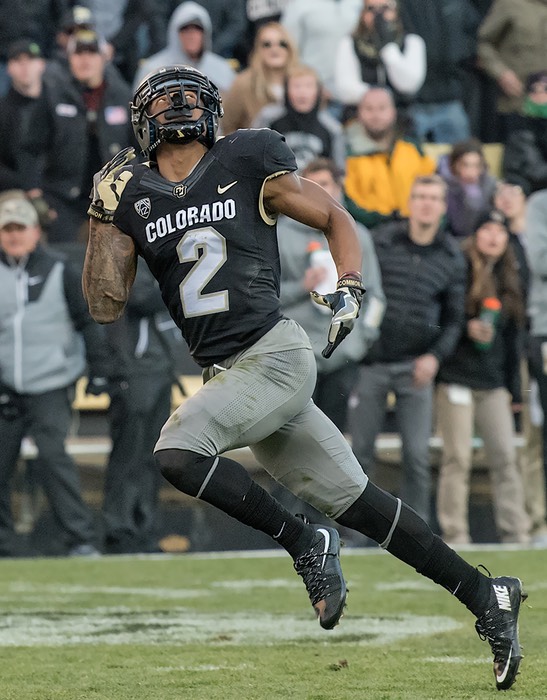
I quickly flipped from shooting the quarterback over the line of scrimmage to finding the receiver he was throwing to. This was something that we generally didn’t do in the not-to-distant past as the focus system really didn’t recover fast enough to get anything usable. But with the D500 and 70-200mm f/2.8E combo I had no issues with that at all. It’s kind of interesting to see a sequence where I pan fast from quarterback to receiver in post where image 1 (quarterback) is sharp, image 2 isn’t because it’s in the middle of a rapid pan, but image 3 (receiver, above) is.
Vibration Reduction: Nikon doesn’t make any mention of this, but VR has changed in many of the recent lenses. Whereas I’d tend to call the older VR systems a bit on the nervous side—you can easily see them doing the adjustment if you’re sloppy in your hand holding—the latest versions are eerily fast and stable, so much so that you sometimes question whether you’ve got VR enabled. VR is also now quieter.
Overall, the CIPA numbers don’t seem to have changed, so Nikon isn’t claiming “better VR,” but frankly, I see better VR out of this lens, and other pros I’ve talked to about it say they see it too. Again, this has more to do with showing a stable and settled view through the viewfinder than perhaps getting the final image more stabilized. Another improvement that’s appreciated.
Sharpness: At virtually every focal length, the new 70-200mm is clearly sharper in the center of the frame than the older versions. Sometimes only a little, sometimes a lot. That’s a bit unexpected, as the second version of the 70-200mm was no slouch, especially at the two ends of the zoom range. At the far full frame corner, the new lens is very visibly sharper than the older lens from 100mm onward; at 70mm they’re very close, and I’d judge my older lens to be equally sharp in the corners at 70mm by f/4 as the new one is. So the difference doesn’t show up as much at 70mm.
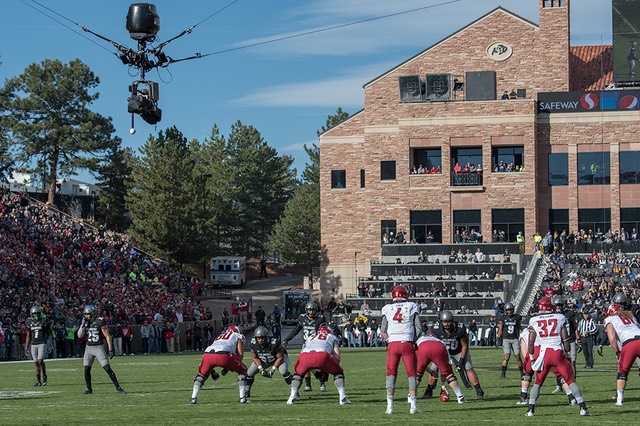
This is generally not a photo I’d tend to take during a game (70mm at f/5.6), but I was curious how the new lens would handle front-to-back and side-to-side at 70mm. In a word: excellently. There just isn’t much to complain about. The older 70-200mm f/2.8G VRII had a tendency towards softness to the edges when you’d try something like this, and tended to also show some chromatic aberration, as well.
But let’s back up a moment. Overall, I’d say that the VR II version of the lens was very sharp at 70mm, dipped quite a bit in the middle range, then improved to be again be very sharp at 200mm. Certainly the center was very sharp at the two ends. My usual term I’d use for that level of sharpness is “excellent." The new version is equally sharp at 70mm, clearly and dramatically sharper in the middle range, and clearly sharper at 200mm. I’d call this level of sharpness “superb.” So for center of frame: old lens excellent, new version superb.
The new 70-200mm also holds up the corners far better than the older lens. Even at 70mm the corners are somewhat improved on the new lens, though they were already very good on the old lens. I’d further note that the older lens tends to slope off from center sharpness to corner sharpness in a fairly regular way: the further you get away from center, the worse the performance is. The new lens retains sharpness further away from center before drop finally dropping a bit in the extreme corners.
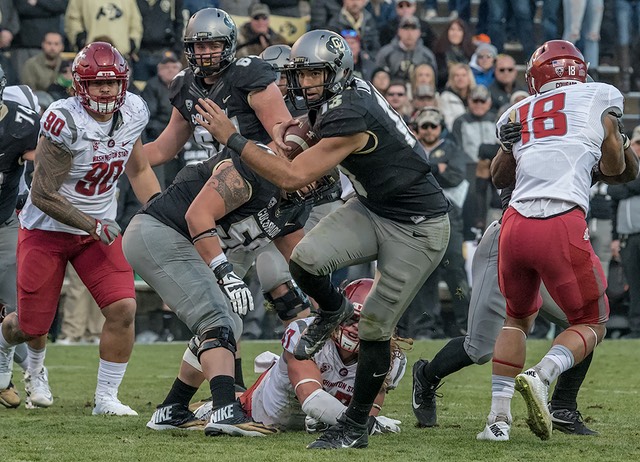
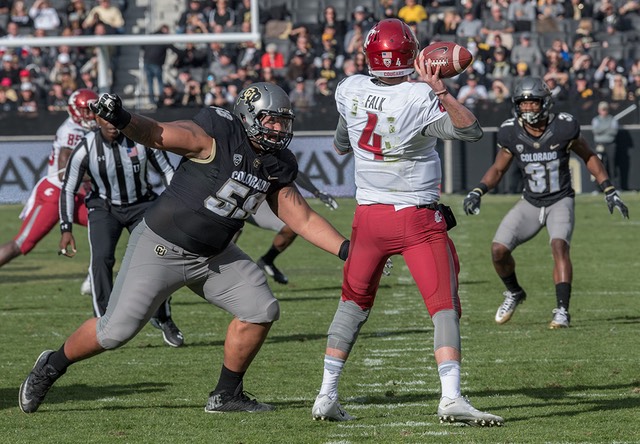


What’s surprising to me is just how nearly edge-to-edge sharp the 70-200mm f/2.8E is from 135-200mm. This seems to be Nikon’s new mantra, as I’ve been writing something pretty similar about all the recent high-end Nikkors lately.
Overall, there’s just no other way to describe this 70-200mm’s ability to pop the focus plane to high acuity than “very sharp.” Every photographer I’ve talked to using the new version speaks about the improved results in this category (less so in the other things I mention about the lens’ performance). Every one. So one has to conclude that the difference in acuity this lens produces when handled well is enough different that it’s visible to all practitioners. That’s a rarity in pro lens redesigns. Usually there’s less unanimity in conclusions, and less clarity in the difference.
Any way you look at it, the 70-200mm f/2.8E is sharp. Sharp for a zoom lens, sharper than older similar lenses, sharp like a prime.
But...this lens does have a visible focus shift as you stop down. Some Nikon bodies (e.g. D5, D810) now do correct for this, though it's unclear exactly what models do and whether it's the camera firmware or the lens correction firmware that is providing this. Nikon not only needs to publicize which bodies have this firmware change, but also make sure that all the current bodies get it.
Chromatic Aberration: Pretty benign. Yes, there’s a bit of both forms of chromatic aberration, but frankly, I wasn’t finding it a problem, even uncorrected (all the images above are uncorrected for CA).
Vignetting: At 200mm, the new lens vignettes more than the lens it replaces at f/2.8, but by even just f/4 it vignettes less. I was surprised at that, and don’t know how to explain the very quick recovery of vignetting performance as you stop down. Generally zooms don’t just quickly pop away from vignetting as you stop down. But this one does.
Flare: Flare is different on the new lens versus the old. Whereas the older version tends to flare quite a bit, it does so broadly, with very wide artifacts. So wide, in fact, that sometimes you just don’t see them, only the reduction in contrast. The new lens has more overall contrast in the same situation, but it produces small, more visible, colored artifacts. In essence, you’ll find yourself doing a bit of cloning from time to time with the new lens, while with the older version you couldn’t really clone to clean things up. Some will see that as an improvement, some will just see it as a change ;~).
Linear Distortion: There’s a bit of barrel distortion at 70mm that’s mostly ignorable, obvious pin cushion at 200mm that you’ll want to correct, though it’s not obnoxious.
Focal Length Breathing: I know you’ve been waiting for this discussion. Does it breath? Not really. Most varifocal zooms have a small bit of focal length change as you focus closer, but the second version (VRII) of the 70-200mm was notorious for clear focal length reduction, all the way down from 200mm to about 135mm equivalent when focused close. The new lens breathes a very small and reasonable amount, not enough to worry about. 200mm at close focus distance is less than 3% different in measured focal length than at infinity. That’s what we expect and want from our lenses, I think. (Videographers, of course, want parfocal zooms, which make absolutely no change when focused close or far. None of the 70-200mm’s have been parfocal.)
Bokeh: I’m not sure that we should be putting too much discussion into bokeh on an f/2.8 lens. Like most recent Nikkors, the transition from focus plane to out-of-focus is very well behaved. Background highlights aren’t overly busy, though they sometimes have a bit of edging to them due to a minor amount of longitudinal chromatic aberration and spherical aberration.
Overall: I know others have said something similar, but it has to be said here, too: this is the most prime-like zoom I’ve seen from Nikon. Maybe from anyone. Because zooms have many more elements in them—and the extra glass/air surfaces that this implies—and because zooms have much more complexity in how the optical path changes as you twist the rings on the lens, they almost always test worse than primes. The zoom designers are just fighting too many variables the prime designers don’t have to.
Yet somehow this new 70-200mm f/2.8E tests a lot like a prime. Let me put it a different way. If I were to test a 70mm f/2.8 prime and get the results I got from this zoom, I’d be happy. If I were to test a 135mm f/2.8 prime and get the results I got from this zoom, I’d be happy. If I were to test a 200mm f/2.8 prime and get the results I got from this zoom, I’d be more than happy. Indeed, at every focal length this lens is up in the “pretty darned good prime” territory. Enough so that I had to update my Rationalizing Lenses article.
Let me put it another way: at present the only three primes I know of that perform better than the 70-200mm f/2.8E at the same focal length are the 200mm f/2, the recent Nikkor 105mm f/1.4E, and the 85mm f/1.4 Zeiss Otus. That’s saying a lot.
Final Words
As seems typical lately, Nikon is designing to a higher standard with the high-end Nikkors, and the 70-200mm f/2.8E FL is no exception. The difference is most noticeable wide open and into the corners, and on this lens, particularly as you zoom in to 200mm.
This is the best 70-200mm I’ve used to date, from any manufacturer. Snappy focus, good VR, dramatic sharpness throughout, no terrible faults. It’s very easy to recommend this lens.
Highly Recommended (2017 to present)
Support this site by purchasing from the following advertiser:
